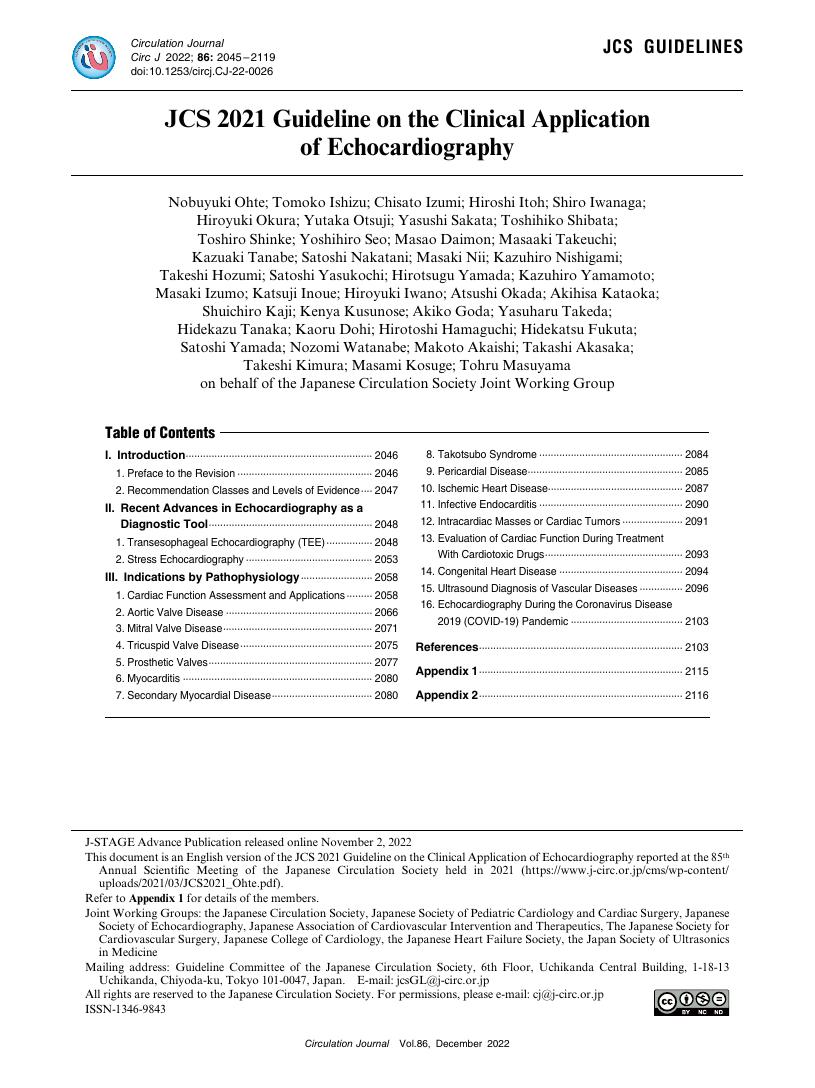- 著者
- Naoko Sawada Koki Nakanishi Tomoko Nakao Tatsuya Miyoshi Masaaki Takeuchi Federico M. Asch Roberto M. Lang Masao Daimon
- 出版者
- The Japanese Circulation Society
- 雑誌
- Circulation Reports (ISSN:24340790)
- 巻号頁・発行日
- pp.CR-23-0076, (Released:2023-10-18)
- 参考文献数
- 16
Background: Although accurate assessment of right ventricular (RV) morphology and function is clinically important, data regarding reference values for echocardiographic measurements of the right ventricle in the Japanese population are limited.Methods and Results: The World Alliance Society of Echocardiography (WASE) Normal Values Study was conducted to examine normal echocardiographic values in 15 countries. Using the WASE study database, we analyzed 2-dimensional echocardiographic parameters of RV size and systolic function in 192 healthy Japanese individuals and compared them with those obtained from 153 healthy American individuals. In the Japanese population, the absolute values of RV dimensions were smaller for women than men, although the difference disappeared after the data were adjusted for body surface area. RV dimensions, RV length and RV area were smaller in the elderly, but age did not affect RV systolic function. The absolute value, but not the adjusted value, of RV size tended to be smaller in Japanese than American individuals for both sexes. For men, RV systolic function parameters were lower in the Japanese population. This trend was not seen in women.Conclusions: The present study identified normal reference values for RV size and systolic function in a healthy Japanese population. Sex, age, and race had a significant impact on RV size; however, this trend was weak for RV systolic function.
- 著者
- Nobuyuki Ohte Tomoko Ishizu Chisato Izumi Hiroshi Itoh Shiro Iwanaga Hiroyuki Okura Yutaka Otsuji Yasushi Sakata Toshihiko Shibata Toshiro Shinke Yoshihiro Seo Masao Daimon Masaaki Takeuchi Kazuaki Tanabe Satoshi Nakatani Masaki Nii Kazuhiro Nishigami Takeshi Hozumi Satoshi Yasukochi Hirotsugu Yamada Kazuhiro Yamamoto Masaki Izumo Katsuji Inoue Hiroyuki Iwano Atsushi Okada Akihisa Kataoka Shuichiro Kaji Kenya Kusunose Akiko Goda Yasuharu Takeda Hidekazu Tanaka Kaoru Dohi Hirotoshi Hamaguchi Hidekatsu Fukuta Satoshi Yamada Nozomi Watanabe Makoto Akaishi Takashi Akasaka Takeshi Kimura Masami Kosuge Tohru Masuyama on behalf of the Japanese Circulation Society Joint Working Group
- 出版者
- The Japanese Circulation Society
- 雑誌
- Circulation Journal (ISSN:13469843)
- 巻号頁・発行日
- vol.86, no.12, pp.2045-2119, 2022-11-25 (Released:2022-11-25)
- 参考文献数
- 460
- 被引用文献数
- 16
- 著者
- Masakazu Yamagishi Nagara Tamaki Takashi Akasaka Takanori Ikeda Kenji Ueshima Shiro Uemura Yutaka Otsuji Yasuki Kihara Kazuo Kimura Takeshi Kimura Yoshiki Kusama Shinichiro Kumita Hajime Sakuma Masahiro Jinzaki Hiroyuki Daida Yasuchika Takeishi Hiroshi Tada Taishiro Chikamori Kenichi Tsujita Kunihiko Teraoka Kenichi Nakajima Tomoaki Nakata Satoshi Nakatani Akihiko Nogami Koichi Node Atsushi Nohara Atsushi Hirayama Nobusada Funabashi Masaru Miura Teruhito Mochizuki Hiroyoshi Yokoi Kunihiro Yoshioka Masafumi Watanabe Toshihiko Asanuma Yuichi Ishikawa Takahiro Ohara Koichi Kaikita Tokuo Kasai Eri Kato Hiroshi Kamiyama Masaaki Kawashiri Keisuke Kiso Kakuya Kitagawa Teruhito Kido Toshio Kinoshita Tomonari Kiriyama Teruyoshi Kume Akira Kurata Satoshi Kurisu Masami Kosuge Eitaro Kodani Akira Sato Yasutsugu Shiono Hiroki Shiomi Junichi Taki Masaaki Takeuchi Atsushi Tanaka Nobuhiro Tanaka Ryoichi Tanaka Takuya Nakahashi Takehiro Nakahara Akihiro Nomura Akiyoshi Hashimoto Kenshi Hayashi Masahiro Higashi Takafumi Hiro Daisuke Fukamachi Hitoshi Matsuo Naoya Matsumoto Katsumi Miyauchi Masao Miyagawa Yoshitake Yamada Keiichiro Yoshinaga Hideki Wada Tetsu Watanabe Yukio Ozaki Shun Kohsaka Wataru Shimizu Satoshi Yasuda Hideaki Yoshino on behalf of the Japanese Circulation Society Working Group
- 出版者
- The Japanese Circulation Society
- 雑誌
- Circulation Journal (ISSN:13469843)
- 巻号頁・発行日
- pp.CJ-19-1131, (Released:2021-02-16)
- 参考文献数
- 1401
- 被引用文献数
- 50
2 0 0 0 OA The Mitral L Wave
- 著者
- Hiromi Nakai Masaaki Takeuchi Tomoko Nishikage Toshiki Nagakura Shinichiro Otani
- 出版者
- The Japanese Circulation Society
- 雑誌
- Circulation Journal (ISSN:13469843)
- 巻号頁・発行日
- vol.71, no.8, pp.1244-1249, 2007 (Released:2007-07-25)
- 参考文献数
- 25
- 被引用文献数
- 8 21
Background The prominent mid-diastolic filling wave (mitral L wave) indicates advanced diastolic dysfunction in patients in sinus rhythm. The aim of the present study was to determine the clinical implications of the mitral L wave in patients with atrial fibrillation (AF). Methods and Results Ninety-nine consecutive non-valvular chronic persistent AF patients were enrolled. The mitral L wave was defined as a distinct mid-diastolic flow velocity following the E wave with a peak velocity >20 cm/s. The prevalence of the L wave in AF patients (34/99, 34%) was significantly higher than that observed in patients in sinus rhythm during the same study period (23/946, 2.4%, p<0.001). Patients with AF and L wave were older, more frequently female and had a slower heart rate, shorter isovolumic relaxation times, larger E wave velocities and lower early diastolic mitral annulus velocity (E') resulting in the higher E/E' compared to those without L waves. The left atrial volume index was significantly larger in patients with an L wave. The Valsalva maneuver decreased, and leg elevation increased, the amplitude of the L wave in the subset of patients who received these procedures. Conclusions The appearance of the mitral L wave in AF is relatively common, and its presence indicates advanced diastolic dysfunction, including elevated filling pressures and distended noncompliant LA. (Circ J 2007; 71: 1244 - 1249)
